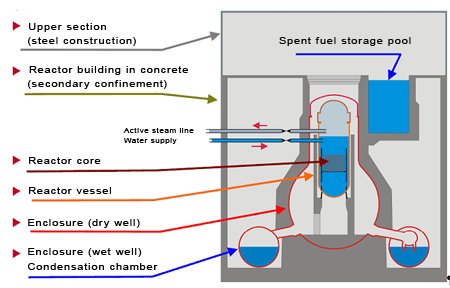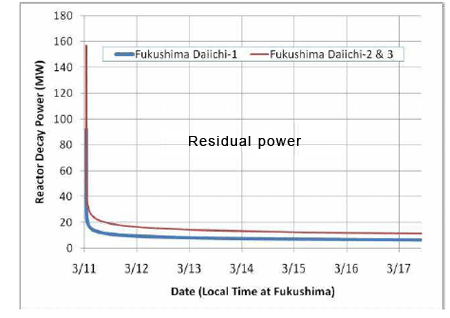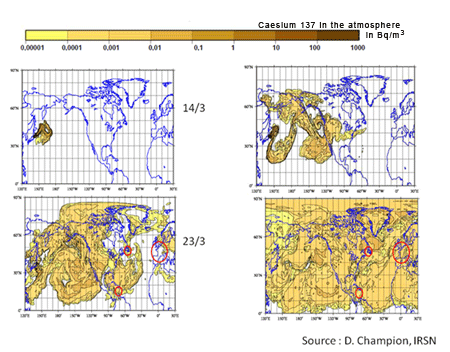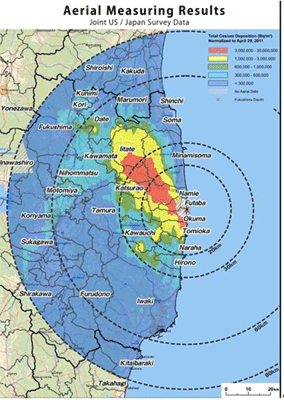

The High Scientific Council (HSC) of ENS recently presented a position paper on the causes, consequences and lessons to be learnt from a technical perspective from the nuclear accident that occurred at the Fukushima Daiichi nuclear power plant in the wake of the earthquake and tsunami that struck Japan on 11 March 2011.
ENS NEWS is pleased to be able to share this position paper with its readers.
High Scientific Council position paper: The accident at Fukushima
On 11 March 2011, Japan was hit by an earthquake and tsunami of exceptional magnitude. These two inter-connected events triggered a major nuclear accident at the Fukushima Daiichi nuclear power plant. The power plant is situated to the South of Sendai, on Japan’s North Eastern coast. It contains 6 boiling water reactors (BWRs). Three of them were operational at the moment when the earthquake struck.
The plant’s reactors were built over a number of years: the first one, which has a capacity of 480 MWe, achieved criticality in 1970. The subsequent units, with an increasing capacity ranging from 780MWe to 1,100 MWe, were connected to the grid between 1973 and 1979. Units 1, 2, 3 and 4, which were damaged by the accident, are BWR GE Mark I type reactors designed by General Electric.
In a BWR the water is allowed to boil in the reactor’s primary circuit under a pressure of 70 bars. The steam that is produced at a temperature of 285°C is conveyed directly to the turbines that operate the electricity generators. After passing through the turbine the steam is condensed in a device that brings it into thermal contact with a heat sink, which in the case of Fukushima was sea water. So, this kind of reactor has a single, long closed circuit, which leaves the confinement area and the reactor building en route to the turbines and the condenser. The confinement area consists of a dry well around the reactor core that is made out of steel reinforced concrete and has a small volume of 11,000m-3 filled with an inert gas (nitrogen), and a wet well, which is a torus-shaped pool that acts as the reactor’s water reserve and condensation chamber. The whole thing is enclosed in the reactor building, which also contains a storage pool in which spent fuel removed from the reactor core is submerged (Figure 1).

Fig. 1: The main elements of a BWR GE Mark I reactor
How events unfolded
The epicentre of the earthquake, which registered 9 on the Richter scale, was around 100 km off the coast of Japan. It provoked ground accelerations of 0.37g, whereas the nuclear power plant was designed to resist accelerations of up to 0.3g. In spite of this, the installations appear to have resisted the earthquake well, thanks to margins of security that are foreseen by the rules governing para-seismic construction. The earthquake caused the automatic shut-down of the reactors by the insertion of safety rods. It also caused the loss of the plant’s external electricity supply. At this stage the back-up electricity supply (diesel generators) started working correctly, thereby enabling water circulation within the reactor’s primary circuit to be maintained and facilitating the cooling of the reactor once it shut down. Unfortunately, the tsunami that followed the earthquake and struck the coast around one hour later reached an estimated height of 14m, which is far higher than that of the 6.5m high dikes. The tsunami swept away the 4 marine pumping stations that supply the condenser and flooded the diesel generators, leaving the reactors without any electricity supply or heat sink.
What followed was a race against time to avoid the overheating of the reactors. In fact, even if the chain reaction is stopped and there are no more neutrons in the
reactor cores, the residual power generated by the fission products must still be removed.
Residual power
The fission products are nuclei with a strong excess of neutrons, inherited from their parent uranium nucleus, and which makes them unstable. Consequently, most fission products are radioactive, with half-lives ranging from a micro second (or even less) to tens of millions of years. It is the radioactive decay of the fission products that is responsible for the residual power that is given off by a recently shut-down reactor core.
When the reactor shuts down the residual power represents 7% of its nominal thermal power. This level then decreases over time at the same rate as the decay of the radioactive fission products. (Figure 2). Three hours after the shut-down the remaining residual power represented no more than 3% of the nominal power. One day later, only 1%.

Figure 2: How the power of a nuclear reactor evolves when the chain reaction stops
The residual power then stabilises and further decreases, but only slowly, representing a fraction of the percentage of the reactor’s nominal power. Four days after the accident, the power emanating from the core was around 7 MW for reactor 1 and 13 MW for reactors 2 and 3. Even if this represents only a fraction of the nominal power of the reactors it is, nonetheless, far from negligible (equivalent to that emitted by around 10,000 domestic central heating radiators). It is easy to understand, therefore, why it is necessary to cool down the core in order to avoid it overheating. Failure to maintain this cooling process right from the beginning is what caused the accident. |
The accident scenario progressed slowly. Right from the start, the main objective was to avoid damage to the fuel. To achieve this, the core had to be kept underwater. Initially, the steam produced by the reactors enabled a small emergency turbine to function and allow the primary circuit water to flow. In the absence of a heat sink this solution only enables calories to be transferred from the core to the torus-shaped pool in the wet well. The water is vaporised in the core and then condenses in the wet well, where the average level and temperature increase accordingly. During the initial hours after the earthquake struck, the water level in the reactor was maintained with the addition of water from a surge tank. This process continued until the surge tanks were empty. The wet well is designed to resist a pressure of only 4 bars and in order to limit the pressure in it the operator, TEPCO, was obliged to release some steam into the reactor building.
Once the reserve water had been used up the operators had no choice but to continue to vent steam into the reactor building. The water level in the reactor vessel then began to drop and the reactor core was exposed. No longer cooled by the water in the reactor vessel the fuel rods broke up, releasing the volatile fission products that they had hitherto contained. At the same time, because the temperature of the cladding reached 1200°C, the water triggered the oxidation of the zirconium in the cladding, which in turn produced hydrogen mixed in with the water vapour.
The operators attempted to save the reactor by voluntarily releasing steam, under controlled conditions, first to the confinement area and then into the upper section of the reactor building. At this stage, the steam released outside the plant was already radioactive. In addition, the hydrogen in the water vapour was released when the reactors were vented. The hydrogen appears to have accumulated at the top of the reactor buildings. Once the percentage of hydrogen in the atmosphere reached 4% it became explosive.

Figure 3: Hydrogen explosion at the Fukushima power plant
A few days after the earthquake hydrogen explosions occurred in units 1, 2 and 3.These blew away the upper sections of reactor buildings 1 and 3. Although the explosions were spectacular they didn’t appear to seriously damage either the confinement areas or the reactor vessels.
However, the venting of reactor 2 occurred too late, which caused a rise in pressure and the rupture of the wet well. This led to the release of a significant amount of contaminated water, which spread to the plant’s technical galleries.
Drastic steps were then taken to cool down the reactors, by whatever means possible, using the only remaining source of water available - sea water. Sea water was, therefore, released into the reactor vessel and the dry well. This method of supplying water, called “feed and bleed,” is carried out at atmospheric pressure; the steam from the boiling of the water was released continuously.
At the same time, the spent fuel storage pools also started to encounter problems. The water in the pools must be cooled by a process of heat-exchange in order to avoid the overheating of the fuel due to its residual heat. Once this heat-exchange could no longer be guaranteed, the water level in the pools began to drop, possibly exposing the spent fuel, which led to the potential deterioration of the fuel cladding and to the release of volatile fission products into the atmosphere. The dosage levels around the reactors were too high to allow the operators to intervene on the spot.
Three months after the accident access to sea water for use as a heat sink was still impossible. The technical galleries and the reactor pools were still full of contaminated water.
The radiological and environmental consequences of the accident
Contrary to the accident at Chernobyl, it was primarily the volatile elements that were released at Fukushima: Kr 85, (radioactive half-life T=1 year) + isotopes of Xe, I 131 (T=8j), Cs 137 (T=30a) and Te 132 (T=3j).
The measurements of radioactivity made in the immediate vicinity of the plant show clearly the maximal levels of radioactivity resulting from the venting of the steam and the hydrogen explosions.

Figure 4: The dispersal of the radioactive cloud
The radioactive cloud that had been formed by successive bursts then dispersed (Fig. 4). Luckily, during the acute phase of the accident the wind was blowing primarily from the West, towards the ocean. Then atmospheric dispersal took over, homogenising over a period of fifteen days the concentration of radioactive gas in the Northern hemisphere. The accident would have been very different had the wind blown instead towards Tokyo…
The accident at Fukushima triggered a release of caesium into the air, which was measurable everywhere in the Northern hemisphere. During the 1960s and the 1980s, the concentration of caesium in the air was at first due primarily to the carrying out of nuclear tests. Later it was associated with the Chernobyl accident. As was the case with these previous episodes of pollution, a decrease in the peak level resulting from the Fukushima events was observed. It occurred at a rate consistent with that of caesium depletion from the atmosphere provoked by rainfall; and it occurred within a time period of around 1 month.
The local radiological consequences registered are modest: 30 people were irradiated after receiving a dose superior to 100 mSv, but their lives are not in danger.
Radioactive measurements carried out in the environment surrounding the plant indicated spikes associated with the explosions. The maximum dose level registered around the reactors (at the entrance to the plant) was around 10 mSv/hour, and 400 mSv/hour close to reactor N° 3. On 16 March, five days after the accident, the level at the entrance to the plant was 1.5 mSv.
As far as leaks into the sea were concerned, the radioactivity measured close to the plant during the early stages of the accident was primarily from iodine 131. Thereafter, it was mostly caesium 137 and 134. However, thanks to dilution this dropped rapidly and had reached the legal permissible limit by the end of April, around one and a half months after the accident. It was later confirmed that because the elements released are naturally soluble in water, they quickly dispersed in the ocean. Contamination of local fishes is and will be detectable, but it is not expected that strong concentrations of iodine or caesium will be registered within the different layers of the marine biosphere.
The radiological consequences of the accident at the regional level resulted from the contamination of the atmosphere by noble gases, such as iodine and caesium, and by the contamination of the soil due to atmospheric fall-out. This contamination of the soil can affect the population due to external irradiation or as a result of the ingestion of agricultural products. The evacuation of the 20 km buffer zone that the Japanese authorities decided to impose avoided any significant exposure of the population to this contamination.

Figure 5: Map of soil contamination (source: website of MEXT)
Unfortunately, the wind did not always blow from the West. For a brief period, on 15 and 16 March, the wind - accompanied by rain and snow - blew from the South East. This created atmospheric fall-out and significant levels of soil contamination from caesium in the so-called “Iitate corridor” – a strip of land around 50 km long and 10 km wide, which registered caesium contamination in excess of 3 million Bq/m2. If no counter measures are taken, this contamination will cause the build-up of radioactive doses, during the first year after the accident, equivalent to several tens of mSv. This will render the soil in an area of a few hundred km2 unsuitable for sustainable agricultural use. Steps to evacuate this corridor, which extends beyond the 20 km evacuation area, have been taken.
The dose received by the public two months following the accident at Fukushima is less than 1 mSv, except for in the Iitate corridor, where it is closer to 10 mSv.
Bearing in mind the dose levels to which the public has been exposed, no significant health effect on the population is expected as a result of the Fukushima accident.
There are three reasons why the excessive number of thyroid cancer cases that occurred in the region of Chernobyl should not be repeated in Japan: firstly, the amounts of iodine released so far have been ten times less than those released following the Chernobyl accident; secondly, because the population was evacuated quickly the dose received is very much less; finally, because the Japanese population lives close to the sea it is not deficient in iodine and would probably have accumulated radioactive iodine much less efficiently (in the thyroid) than their Ukrainian and Belorussian counterparts.
In Europe, radioactive Iodine 131 was measured both in the atmosphere (in mBq/m3 at the height of the crisis) and in rain water (measured in Bq/L), but the dosimetric impact was extremely low.
Since the accident at Fukushima destroyed four of the plant’s six reactors, causing major radioactive leaks into the environmental and potential associated health effects, it was given the highest possible rating on the INES scale (7), just as the Chernobyl accident was.
Would pressurised water reactors have resisted better?
Yes, at least in the early stages of the accident, because of the presence of a secondary circuit containing non-radioactive water. In the absence of a heat sink, the evacuation of the residual power in a PWR can be carried out in the medium-term by evaporating water from the secondary circuit and by releasing steam from non-radioactive water (this is very different for BWRs) until the reserves of water had been exhausted.
If the absence of a heat sink continues and if re-injecting water into the secondary circuit is not possible, the scenario is then identical for both PWRs and BWRs: the temperature and pressure rise in the primary circuit and it is necessary to vent or release radioactive steam, which runs the risk of exposing the core and producing hydrogen.
The consequences of venting are different for BWRs than for PWRs. With BWRs, the containment building is small and internal pressure rises quickly, whereas the very large containment areas around PWRs allow extra time before having to release radioactivity into the environment. Furthermore, for PWRs the risk of producing hydrogen has been taken into account and avoided thanks to the presence of igniters or catalysts that re-combine hydrogen as soon as it is produced. Had the reactor been a PWR it is unlikely that a hydrogen explosion would have occurred.
Finally, the bottom of the reactor vessel of a BWR is pierced by tight channels through which the control rods pass. These represent weak structural points that undermine the tightness of the vessel in the event of a core meltdown. It seems that leaks from the bottom of the vessels occurred on the Fukushima reactors. By contrast, the bottom of a PWR reactor vessel is not pierced, which probably affords it greater resistance to attack from corium.
With third generation reactors, like the EPR, there probably wouldn’t even have been any release of radioactivity outside the containment area because this type of reactor is conceived to maintain containment even in the event of core meltdown.
Were mistakes made?
Clearly, the accident at Fukushima is unacceptable to the public. The operators did not commit any major errors in the way they handled the crisis. Perhaps they could, however, have avoided core meltdown by deciding very quickly to use sea water to cool the reactors. But this was probably a very difficult decision to make after an earthquake and tsunami of such magnitudes. For technicians and scientists the issue of responsibility should be considered as follows: were the events that triggered the accident (the earthquake and the tsunami) of such an exceptional magnitude that the risk of them occurring was probably an acceptable one to take (in which case the extraordinary bad luck associated with the events absolves the technical community from any blame), or was the probability of their occurring sufficiently high to have foreseen measures to protect against such a risk (in which case the Japanese technical community was wrong not to have foreseen them).
Seismic risk can be calculated quite accurately. The Gutenberg-Richter Law, which links exponentially the magnitude and occurrence frequency of an earthquake, is a universal law. In principle, it enables the probability of strong earthquakes to be evaluated by observing weak earthquakes and then extrapolating. Assessing the risk of a tsunami occurring is more difficult! It is, of course, linked to the aforementioned earthquake, but how the continental shelf and the coastline are configured have a fundamental effect and in turn make evaluating the probable height of the wave much harder to do.
Gigantic tsunamis frequently occur in the Gulf of Alaska (one of 60m high occurred in 1899 and one of more than 70m in 1964!). Unfortunately, Japan doesn’t fare much better (a 38m high tsunami occurred in 1896, another of 12m followed the Kanto earthquake of 1923 and another of 29m followed the Sanriku earthquake of 1933). But waves strike in one place first and then in another. This begs the question of what the probability is, a priori, of a tsunami of above a given height (e.g. the height of the dikes, i.e. around 6.5m) striking Fukushima? A recent report (Ref. T. Annaka et al.: A method of probabilistic tsunami hazard analysis, earthquake engineering symposium, 2006) gives the following reply: the probability is around 10-4/year, with a large degree of uncertainty factored in. This means that at Fukushima a few tsunamis higher than the one that struck Fukushima could occur over a period of 10,000 years.
Since we know that the acceptable level of risk of a serious accident occurring (core meltdown) is considered by nuclear safety authorities in the West (and in Japan) to be around 10-4/year for Generation II reactors and 10-5/year for Generation III reactors, and that the probability of radioactivity being released into the environment is even smaller, we can but conclude that there was inconsistency between the safety doctrine at Fukushima and its actual application. The design basis of the dike was clearly insufficient and the Japanese technical community must be held responsible.
After the accident
After the accident the water used to cool the reactors, which is currently being stored in the plant’s pools and technical galleries has to be decontaminated. Tens of thousands of m3 need to be treated and extracting the caesium from salt water is no easy task, because the water contains a lot of sodium, an element with chemical properties close to the ones of caesium. The soil in the vicinity of the plant and inside the Iitate corridor will also probably have to be decontaminated, either by descaling a few centimetres from the surface or by some other technique yet to be defined. Finally, the damaged reactors will have to be dismantled under what are difficult radiological conditions.
The lessons to be learnt from Fukushima
Sadly, the accident at Fukushima has a lot to teach the technical community. For current and existing reactors we will need to re-consider the risk of natural disasters, in particular tsunamis. Cooling methods will have to be diversified, as will ways of providing emergency back-up power. Passive safety has to be promoted in the reactor design and the reactors themselves will require better instrumentation.
The accident at Fukushima will have an effect upon the development of nuclear worldwide because it occurred right in the middle of the nuclear renaissance - and could stop its momentum. The consequences will probably be limited in China, India and Russia, countries that have confirmed their need for nuclear and their desire to develop it. On the other hand, the consequences have already been far-reaching in the West - Germany, Italy and Switzerland have reviewed their nuclear policy and other countries may follow a similar path. The debate about the future of nuclear, which has been given new impetus as a result of the accident, promises to be heated one. Hopefully, it will be a reasonable debate - one that is free of emotion and takes equal account of the advantages and disadvantages of this energy option.
|

